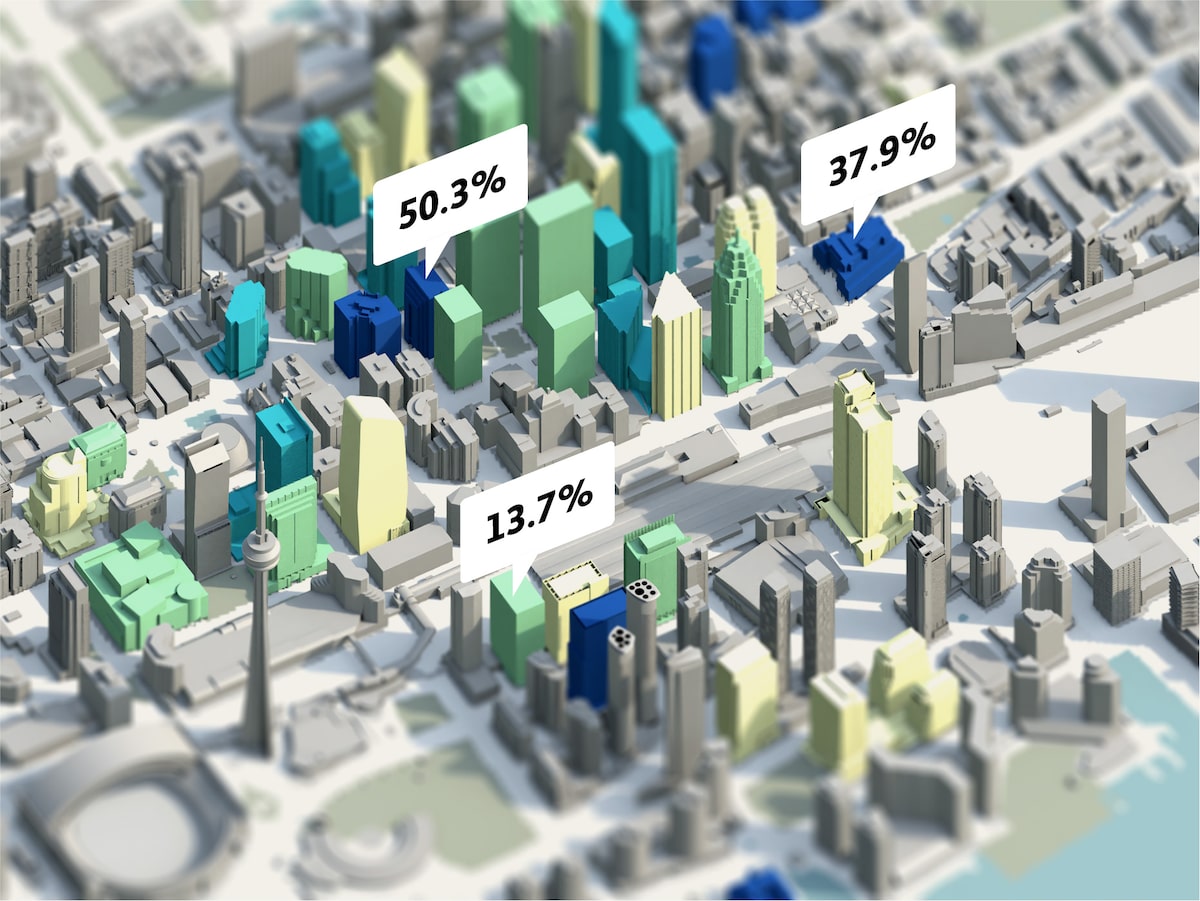With five million square feet of available space across 47 office towers, downtown Toronto is becoming a tenant’s paradise - and an investor’s potential nightmare
Oh no! Not our precious building valuations!!!
Think of the investors
Ohh no rent seekers might find out line can go down… Z herror
downtown Toronto is becoming a tenant’s paradise - and an investor’s potential nightmare

So, good news?
The realtors will find a way to make it bad news, don’t worry.
Privatize the profits, socialize the losses.
Privatize the profits, socialize the losses.
After a few centuries of doing that, how about we try the opposite for a while?
There is an easy fix for the vacancies problem. Lower the rents.
Supply and demand, fuckers.
Oh dear, not building valuations… 🙄
Tangentially, as a homeowner in the GTA I hope this market crashes. I’d love to break even or even take a slight loss on my place. The difference between what I paid 12 years ago and what they’re going for now is just stupid. I’d like to move, but I don’t want to pay the stupid price things are at right now.
No, my building values!!!111!!!
Supply and command… denial and error?
Oh no, not threatening rich people’s yacht money!
Lets turn them into office paintball arenas.
Or… hear me out… apartments?
PAINTBALL ARENA APARTMENTS
I’ve come to collect the ren…ah shit!
I’ve actually heard it’s incredibly difficult to retrofit office space into condos/apartments.
*to profitably retrofit.
Office buildings have too much “inside space”. Regulations, and human life, requires windows for residential living areas, so this inside space is “wasted” in office to apartment refits. There are tons of great ideas on what to do with this space in terms of community space, but very few profitable ones. Once commercial rents crashe and these buildings lose most of their values you’ll be surprised what becomes profitable again lol.
It seems like the obvious answer is to put facilities and businesses in the same buildings instead of nearby. Medical, convenience/light grocery, school rooms, some community centers, civil services, storage, remote work spaces, etc.
I definitely think this is a great answer, with the only caveat being that working in a space that doesn’t have windows all day is pretty lame. I’d like to see what that would look like.
I believe the hurdle for that might be regulatory. For good reason in my opinion because mixing residential and commercial/retail on the same indoor floor has a lot of unique considerations that I’m not sure have been looked at. Letting real estate hedge funds decide based on profit only will be a nightmare lol
Plumbing, apparently, is one issue—residential buildings typically need much more of it than office buildings do. Not an insurmountable problem, but costs $$ to overcome.
The 2 projects I witnessed had to re-do the plumbing, electrical, elevators, fire detection/sprinklers, HVAC, and exterior glass, in addition to gutting every interior wall and doing a full asbestos removal.
It was a lot of work, over several years, but they now have full residential occupancy, so it seems to have worked out.
I’ve actually heard it’s incredibly difficult to retrofit office space into condos/apartments.
It is. Difficult, time consuming and expensive.
But even with that, I’ve seen a couple happen that seem to have been sucessful.
It took them almost 3 years between commercial tenants leaving and residential tenants moving in, but it from what I can tell, it appears to have been sucessful.
I actually used to live in a loft that was a former sears warehouse, it was pretty cool. Had lots of character.
Gladiatorial arenas … where investors can fight one another to death for ownership … broadcast the events on pay-per-view and make money on the events
deleted by creator
Oh no, not the foreign investors that have been driving up housing costs all over North America.
How about fuck those guys. I hope they lose everything.
Supply and demand, motherfuckers.
I shed not one tear for this industry. Not one. The best of them are slide-rule-wielding penny-pinchers that will extract every fraction of a cent they can from you: don’t be successful, because as soon as you look like you’re doing well, your rent will triple.
The worst of them are actual fucking mobsters–greasy hair, shiny clothes, obnoxious cars, silicone-enhanced mistresses, the whole lot of it–who would have you whacked if it made them money.
None of them provide value, they just skim the cream off society and drag the rest of us down. They didn’t even build most of the spaces they’re hocking, they just bought them from their (similarly corrupt) buddies. When we talk about “productivity” being a problem in the Canadian economy, it’s jackasses like this causing it by sucking up all the financial oxygen in the room.
It’s behind a pay wall, however based on the summary, I’m assuming no one brought up that it’s costs an average of $2,600 (per Zumper) for rent downtown and that may be causing issues with not wanting to commute 60+ minutes downtown (per Science Direct on Commuting Times and depressive symptoms in Korea it increases depression)? Or that there’s a ton of Condos for sale that are small and cost a mint to buy?
If thats the case, then the interviews shown don’t seem to be addressing the cause of the issue: it costs a lot to live in downtown Toronto and the median average pay is $69k/yr, per stats canada in 2022, which if we use the 30% rule for rent, means average rent should be $1,725. Now that rule may be outdated, or requires you to live with someone, in your tiny 700 Sq. Ft. Place, and there’s no rent control anymore, so prices can now jump and you have to move? Which is more time spent doing things you hate and having less money? Or that it costs a lot for lunch when you commute unless you dedicate time to meal plan on half a day on the two days you take off during the week? And all of that to have to dress up for work (yay, more costs!) and be interrupted at work, or be guilted into staying later because the boss doesn’t think you achieved anything because you leave at a normal time (that’s anecdotal for me, im just ranting now)
Man I’m frustrated by these articles. Maybe the people who keep bribing our politicians should use some of that money to convince them to make downtown liveable so their office properties keep their value rather then acting like all us workers should just suck it up and come in to help their portfolios.
Finally become good news in the world.
So you take an empty office tower. Make the first two floors shops and services and the remaining floors housing and voila you have in instant walkable community.
Office spaces can be turned into housing as long as they are not too deep, otherwise many rooms will end up without windows and sun light.
I don’t understand the issue of bedrooms without a window. I once lived in a tiny studio apartment with a windowless bedroom. The total dark and silence gave me the best undisturbed sleep I ever had.
Fire codes generally require that bedrooms have 2 exits.
If I exit my bedroom through the window I fall to my death. Not sure how that helps me in a fire.
Who are you, who are so wise in the ways of science?
That worked out ok for one of the 9/11 jumpers. Maybe you could be the next one!
And those rooms could be used for storage, goods and services.
This is the best summary I could come up with:
The planned move to the top of Scotia Plaza has energized the culture and work environment at the firm, he said, adding he hopes it will lure more lawyers back to the office on a regular basis.
KingSett’s chief asset management officer, William Logar did not comment on the rate, but said Scotia Plaza offers a strong combination of location and amenities in a building that is certified as zero carbon.
“Following COVID, lots of employers are quite mindful as to how are we able to attract and have our employees come back to the office,” said Annie Houle, the head of Canada for Ivanhoé Cambridge, which developed and owns CIBC Square.
But the weakness in commercial real estate exposes demographic and technological forces that were already affecting demand for office space before the pandemic, as businesses sought to recruit younger employees by embracing tools that allowed more flexibility in how work got done.
Aside from the sale of 121 King St. W. to Crestpoint early 2022, the only other major transaction in Toronto was the January, 2022, purchase of Royal Bank Plaza by a company controlled by Amancio Ortega, the Spanish billionaire owner of the Zara fashion retail chain, for $1.2-billion.
Unlike developers and other owners that used debt to finance their office portfolios, and have come under intense pressure from rising interest rates that might force some to sell assets, large pension funds are better capitalized with more equity.
The original article contains 3,616 words, the summary contains 241 words. Saved 93%. I’m a bot and I’m open source!
Terrible news Toronto, I’m not from around there but is there a specific charity to donate to, or anything I can do that would help?
I’m accepting donations via paypal on Toronto’s behalf.















